k0ua
Epic Contributor
I thought I would post this thread due to the popularity of the discussion about how to get started into reloading. This tutorial with photos. shows what it is like to load 100 rounds of 9mm pistol ammo on a Dillon RL550B progressive reloading machine.
We start by cleaning and checking out the machine to make sure that everything looks to be in working order. I did tighten the handle retaining nut as it was slightly loose.
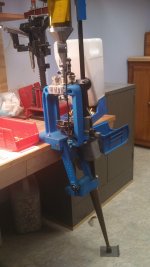
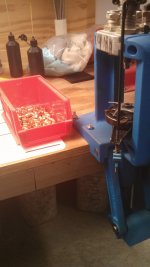
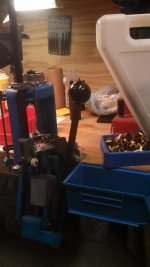
Now lets pickup some primers, there is some powder in the measure, lots of cleaned cases in the dispenser (Old pet food dispenser) some bullets are in the bin and as soon as we get the primers picked up into the pickup tube off of the primer tray and then loaded into the primer magazine tube on the machine (it holds 100 at a time) and now it is time to check our powder charge and then we will be ready to start cranking them out in a hurry.
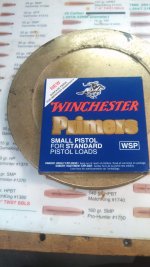
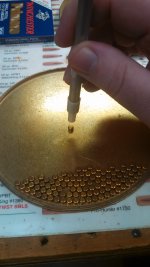
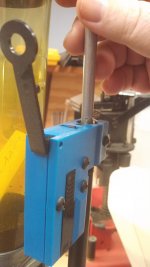
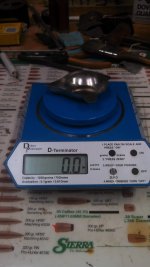
OK our powder charge checks out so I loaded a complete round, going thru all 4 stations 1: re-sizes, de-caps the old primer, and seats a new primer 2: bells the mouth of the case and drops the correct powder charge in the case and 3: seats a bullet to the correct depth, and 4: taper crimps the bullet into the case. (in this type of cartridge intended for an auto pistol, it would roll crimp for a revolver cartridge, it all depends on the die). I then checked the completed cartridge in all dimensions in my Wilson case gauge.
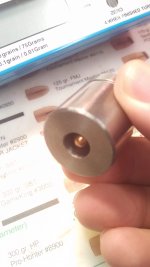
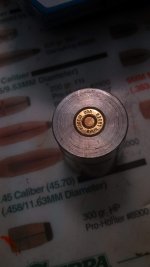
We are now ready to start loading progressively where each pull of the handle will drop a fully loaded cartridge in the collection bin. I keep 4 to 5 empty cases in my right hand and about 10 bullets in my left hand and start by setting a case on station one and a bullet on the case in station 3. Note you only have to handle the case one time. Just keep setting cases and bullets and pull the handle. You will need to index the machine with the bullet seating hand, but your hand is right there anyway, and your thumb and forefinger have already gotten a bullet turned the right way and ready to set it on top of the belled case mouth in station 3. This also gives you a chance to look inside the case in station 3 just before you pull the handle to seat that bullet and make sure there is powder in there. With the powder I use (AA-5 for this 9MM load) there is no way you would not notice a double charge as it would be spilling all over the sides of the case.
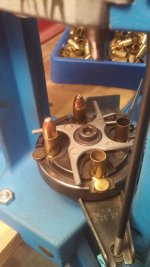
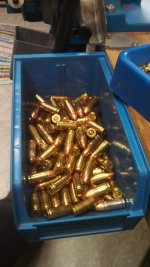
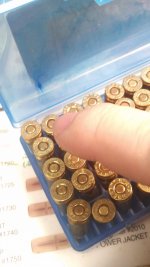
Keep pulling the handle until the primer notification alarm buzzer goes off, and you have 3 more primers in the tube at that point. Look down at the beautiful box of completed cartridges you have created:cool2:
Now is the time to handle every cartridge by putting it in a cartridge box nose first. Look at them and then look at and run your finger over every primer to insure all are seated to the proper depth.
Of course there can be "rejects" or mistakes. I had a few of those even in this session.. One was a 9x21 cartridge case that snuck into the cleaned cases bin. It is 2MM taller than the 9x19 Luger cartridge so its case mouth got belled really excessively. I noticed it at station 2 with the excessive bell. I just dumped its powder back in the powder hopper and discarded it. Of course I wasted that 1 primer.
Also I had a couple of rounds that went all the way through the process, and I noticed them in the collection bin, that they were bulged at the web of the case. The reason for that is that they were probably pretty hot rounds shot in an unsupported maximum chambered gun (as an example a Glock). Glocks (and some others as well) do not have fully supported chambers and tend to run on the maximum side of chamber dimensions. This is done to increase feeding reliability with out of spec or dirty ammo. But this does not always work out so well for the next guy trying to reload those cases from range pickups.
Not all Glock Fired cases will exhibit this bulging problem in the web, but some do. You can usually tell a Glock fired case by the unique firing pin strike, and you can get some idea of the pressure by the primer "flow" around this strike. Here are some of the rejects. The 9x21 case is in the middle, notice the "big bell".
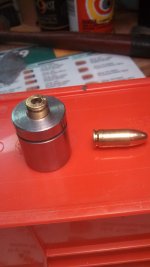
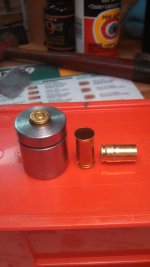
These things are no big deal, you can pull the bullets and save them and the powder with a kinetic bullet puller, but do not attempt to save the primer as the priming pellet is already properly "crushed" in the initial seating process and therefor sensitized, and would not be a good idea to try to seat it again.
I hope this has helped or at least entertained someone out there. Thanks for looking
James K0UA
We start by cleaning and checking out the machine to make sure that everything looks to be in working order. I did tighten the handle retaining nut as it was slightly loose.



Now lets pickup some primers, there is some powder in the measure, lots of cleaned cases in the dispenser (Old pet food dispenser) some bullets are in the bin and as soon as we get the primers picked up into the pickup tube off of the primer tray and then loaded into the primer magazine tube on the machine (it holds 100 at a time) and now it is time to check our powder charge and then we will be ready to start cranking them out in a hurry.




OK our powder charge checks out so I loaded a complete round, going thru all 4 stations 1: re-sizes, de-caps the old primer, and seats a new primer 2: bells the mouth of the case and drops the correct powder charge in the case and 3: seats a bullet to the correct depth, and 4: taper crimps the bullet into the case. (in this type of cartridge intended for an auto pistol, it would roll crimp for a revolver cartridge, it all depends on the die). I then checked the completed cartridge in all dimensions in my Wilson case gauge.


We are now ready to start loading progressively where each pull of the handle will drop a fully loaded cartridge in the collection bin. I keep 4 to 5 empty cases in my right hand and about 10 bullets in my left hand and start by setting a case on station one and a bullet on the case in station 3. Note you only have to handle the case one time. Just keep setting cases and bullets and pull the handle. You will need to index the machine with the bullet seating hand, but your hand is right there anyway, and your thumb and forefinger have already gotten a bullet turned the right way and ready to set it on top of the belled case mouth in station 3. This also gives you a chance to look inside the case in station 3 just before you pull the handle to seat that bullet and make sure there is powder in there. With the powder I use (AA-5 for this 9MM load) there is no way you would not notice a double charge as it would be spilling all over the sides of the case.



Keep pulling the handle until the primer notification alarm buzzer goes off, and you have 3 more primers in the tube at that point. Look down at the beautiful box of completed cartridges you have created:cool2:
Now is the time to handle every cartridge by putting it in a cartridge box nose first. Look at them and then look at and run your finger over every primer to insure all are seated to the proper depth.
Of course there can be "rejects" or mistakes. I had a few of those even in this session.. One was a 9x21 cartridge case that snuck into the cleaned cases bin. It is 2MM taller than the 9x19 Luger cartridge so its case mouth got belled really excessively. I noticed it at station 2 with the excessive bell. I just dumped its powder back in the powder hopper and discarded it. Of course I wasted that 1 primer.
Also I had a couple of rounds that went all the way through the process, and I noticed them in the collection bin, that they were bulged at the web of the case. The reason for that is that they were probably pretty hot rounds shot in an unsupported maximum chambered gun (as an example a Glock). Glocks (and some others as well) do not have fully supported chambers and tend to run on the maximum side of chamber dimensions. This is done to increase feeding reliability with out of spec or dirty ammo. But this does not always work out so well for the next guy trying to reload those cases from range pickups.
Not all Glock Fired cases will exhibit this bulging problem in the web, but some do. You can usually tell a Glock fired case by the unique firing pin strike, and you can get some idea of the pressure by the primer "flow" around this strike. Here are some of the rejects. The 9x21 case is in the middle, notice the "big bell".


These things are no big deal, you can pull the bullets and save them and the powder with a kinetic bullet puller, but do not attempt to save the primer as the priming pellet is already properly "crushed" in the initial seating process and therefor sensitized, and would not be a good idea to try to seat it again.
I hope this has helped or at least entertained someone out there. Thanks for looking
James K0UA
Last edited: